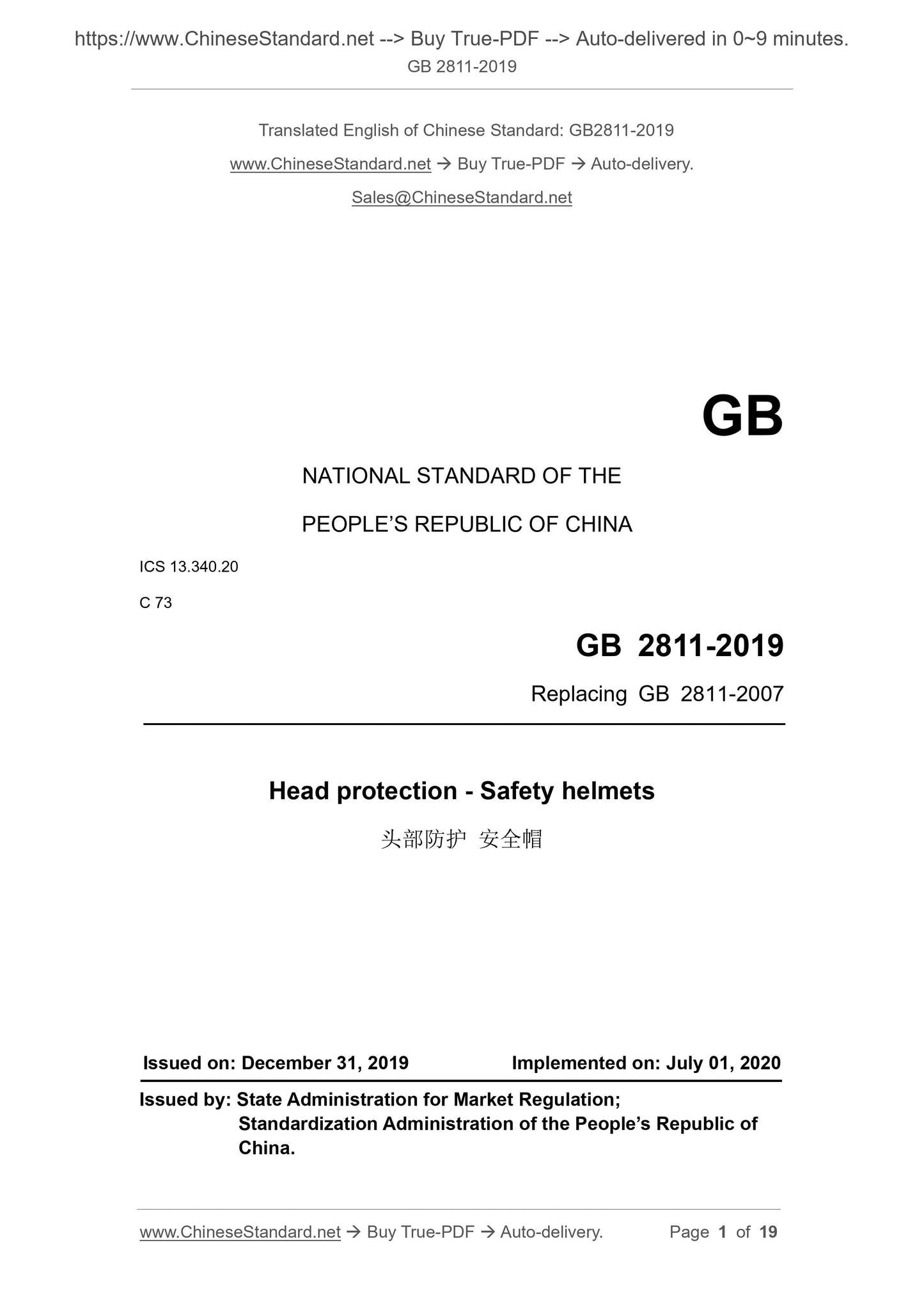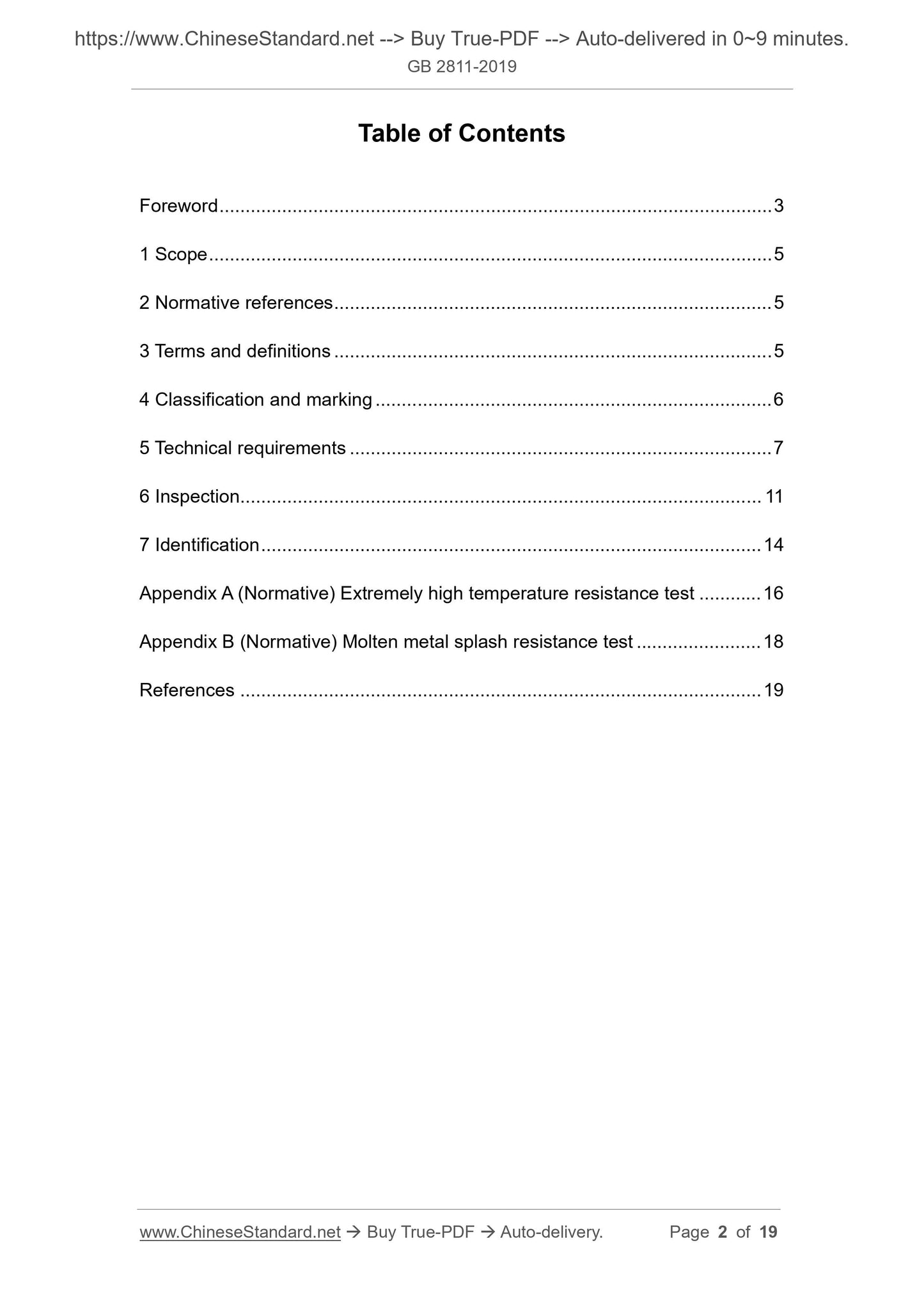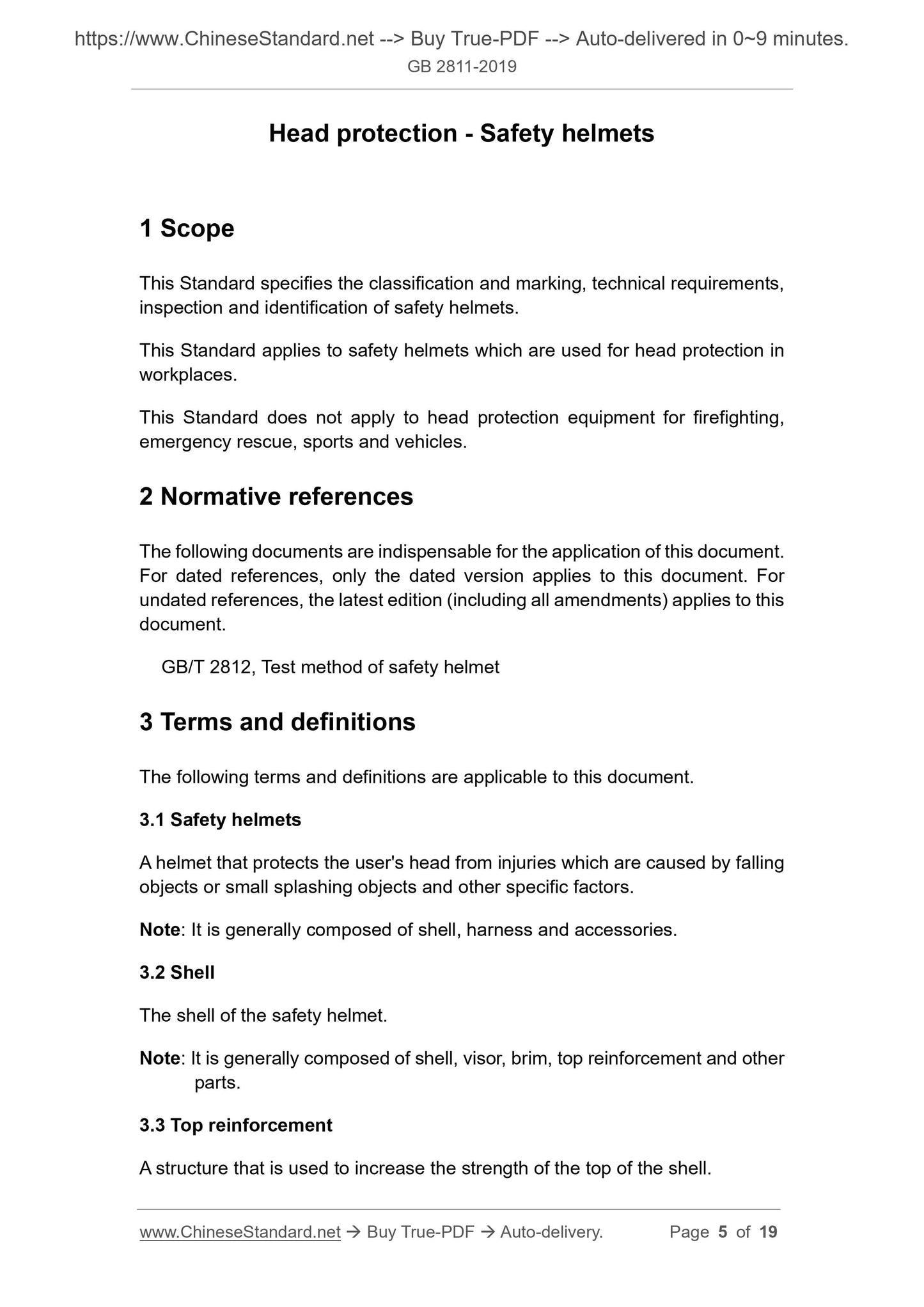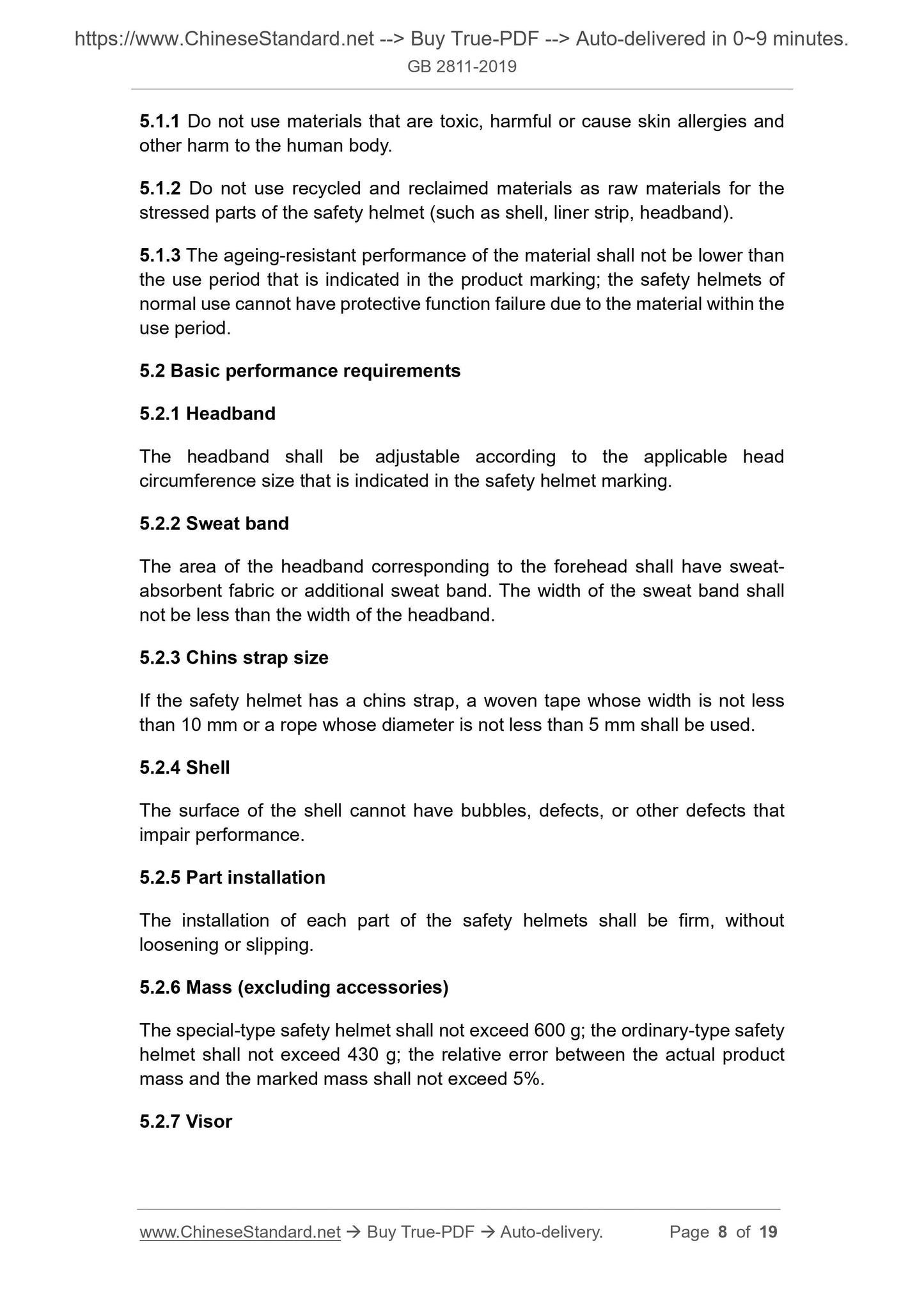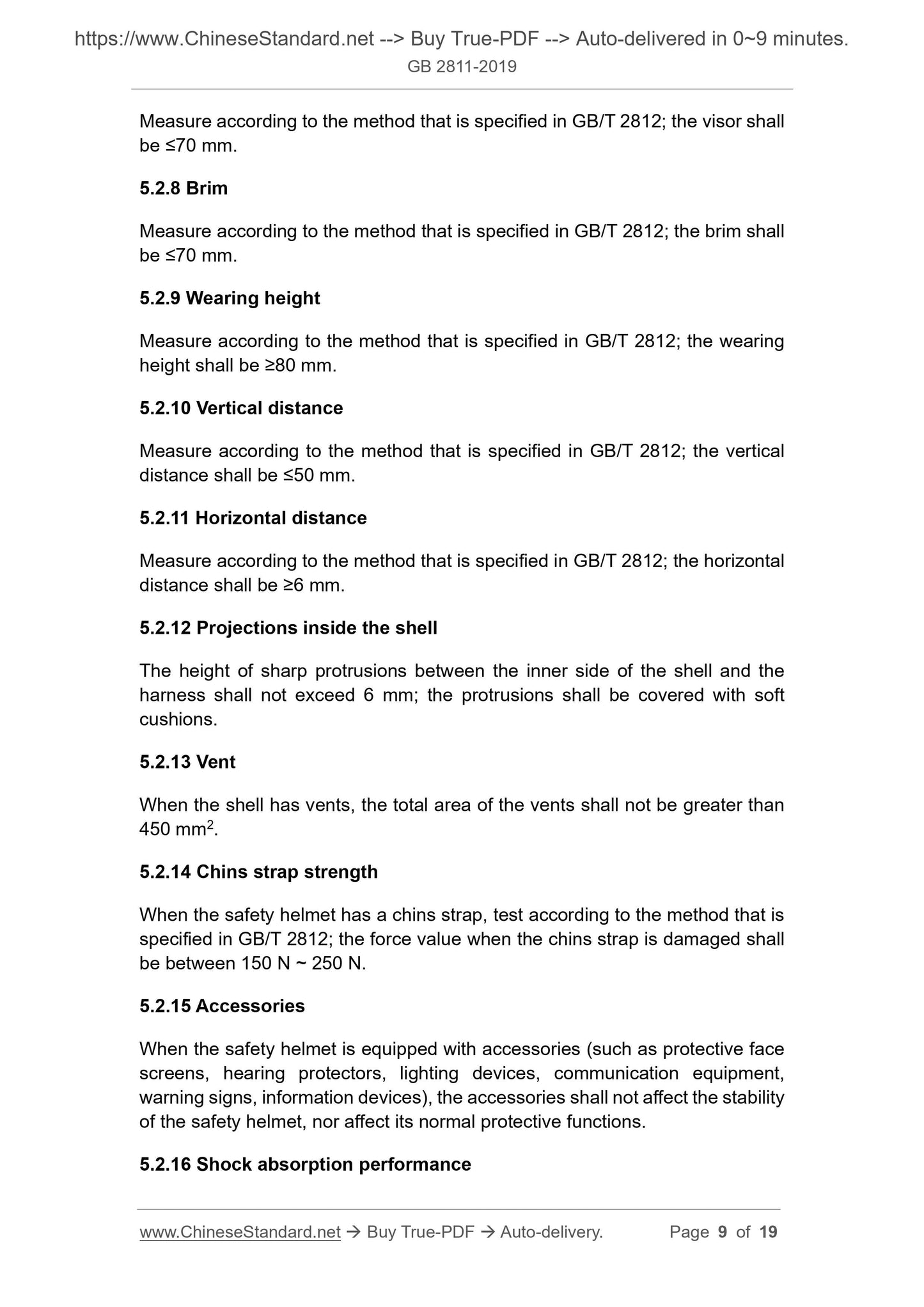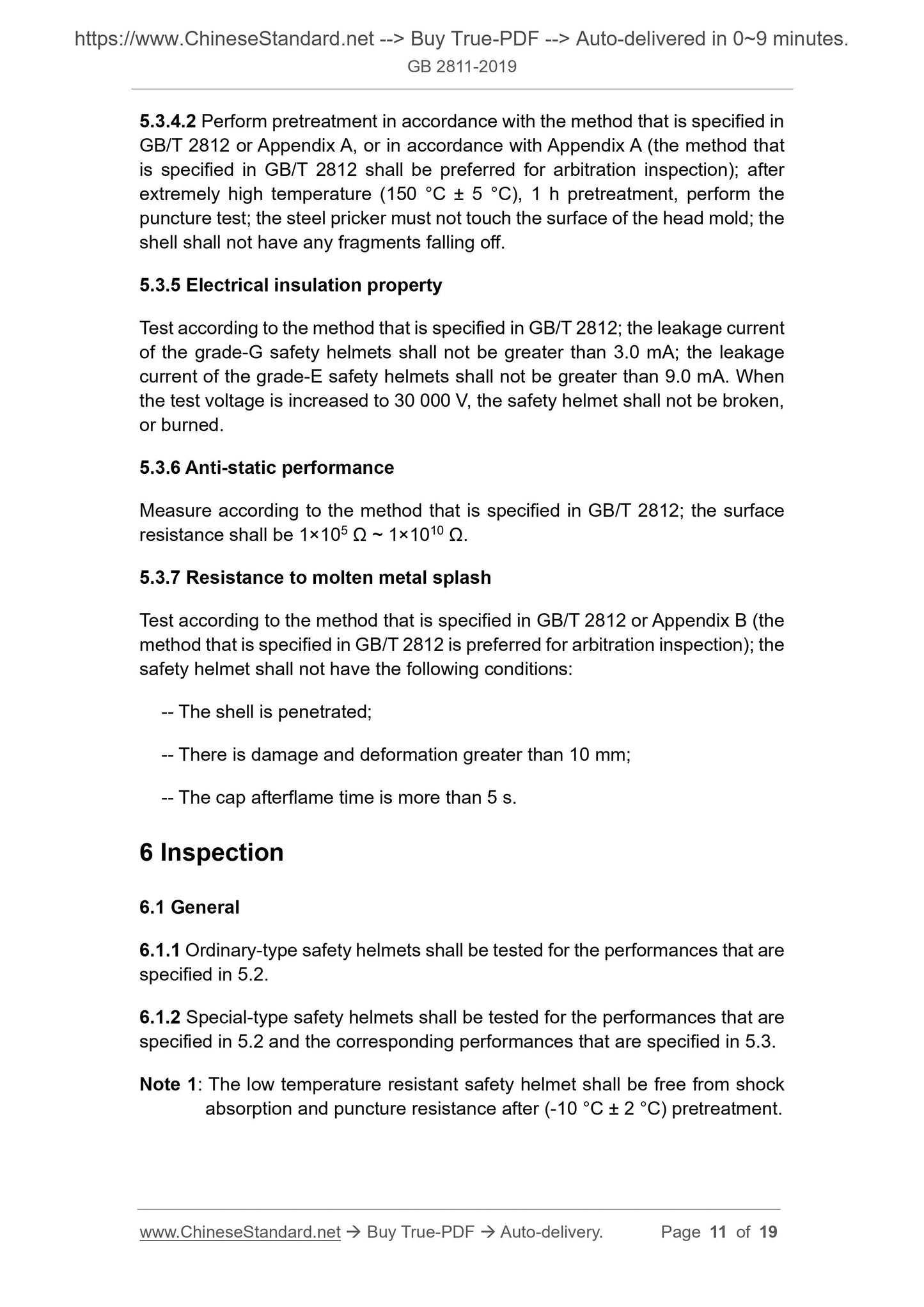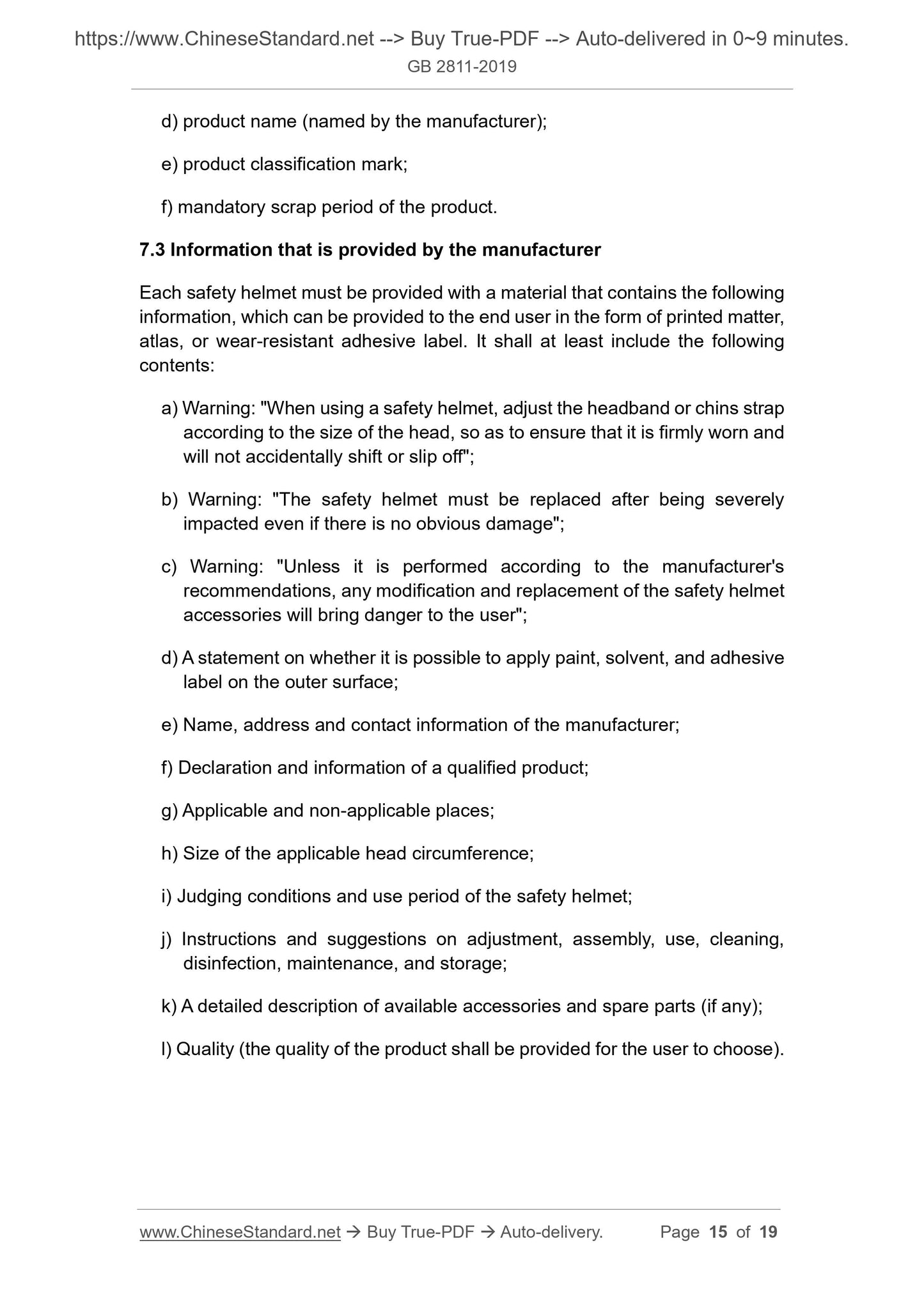1
/
の
7
PayPal, credit cards. Download editable-PDF & invoice in 1 second!
GB 2811-2019 English PDF (GB2811-2019)
GB 2811-2019 English PDF (GB2811-2019)
通常価格
$145.00 USD
通常価格
セール価格
$145.00 USD
単価
/
あたり
配送料はチェックアウト時に計算されます。
受取状況を読み込めませんでした
Delivery: 3 seconds. Download true-PDF + Invoice.
Get QUOTATION in 1-minute: Click GB 2811-2019
Historical versions: GB 2811-2019
Preview True-PDF (Reload/Scroll if blank)
GB 2811-2019: Head protection -- Safety helmets
GB 2811-2019
GB
NATIONAL STANDARD OF THE
PEOPLE’S REPUBLIC OF CHINA
ICS 13.340.20
C 73
Replacing GB 2811-2007
Head protection - Safety helmets
ISSUED ON: DECEMBER 31, 2019
IMPLEMENTED ON: JULY 01, 2020
Issued by: State Administration for Market Regulation;
Standardization Administration of the People’s Republic of
China.
Table of Contents
Foreword ... 3
1 Scope ... 5
2 Normative references ... 5
3 Terms and definitions ... 5
4 Classification and marking ... 6
5 Technical requirements ... 7
6 Inspection... 11
7 Identification ... 14
Appendix A (Normative) Extremely high temperature resistance test ... 16
Appendix B (Normative) Molten metal splash resistance test ... 18
References ... 19
Head protection - Safety helmets
1 Scope
This Standard specifies the classification and marking, technical requirements,
inspection and identification of safety helmets.
This Standard applies to safety helmets which are used for head protection in
workplaces.
This Standard does not apply to head protection equipment for firefighting,
emergency rescue, sports and vehicles.
2 Normative references
The following documents are indispensable for the application of this document.
For dated references, only the dated version applies to this document. For
undated references, the latest edition (including all amendments) applies to this
document.
GB/T 2812, Test method of safety helmet
3 Terms and definitions
The following terms and definitions are applicable to this document.
3.1 Safety helmets
A helmet that protects the user's head from injuries which are caused by falling
objects or small splashing objects and other specific factors.
Note: It is generally composed of shell, harness and accessories.
3.2 Shell
The shell of the safety helmet.
Note: It is generally composed of shell, visor, brim, top reinforcement and other
parts.
3.3 Top reinforcement
A structure that is used to increase the strength of the top of the shell.
5.1.1 Do not use materials that are toxic, harmful or cause skin allergies and
other harm to the human body.
5.1.2 Do not use recycled and reclaimed materials as raw materials for the
stressed parts of the safety helmet (such as shell, liner strip, headband).
5.1.3 The ageing-resistant performance of the material shall not be lower than
the use period that is indicated in the product marking; the safety helmets of
normal use cannot have protective function failure due to the material within the
use period.
5.2 Basic performance requirements
5.2.1 Headband
The headband shall be adjustable according to the applicable head
circumference size that is indicated in the safety helmet marking.
5.2.2 Sweat band
The area of the headband corresponding to the forehead shall have sweat-
absorbent fabric or additional sweat band. The width of the sweat band shall
not be less than the width of the headband.
5.2.3 Chins strap size
If the safety helmet has a chins strap, a woven tape whose width is not less
than 10 mm or a rope whose diameter is not less than 5 mm shall be used.
5.2.4 Shell
The surface of the shell cannot have bubbles, defects, or other defects that
impair performance.
5.2.5 Part installation
The installation of each part of the safety helmets shall be firm, without
loosening or slipping.
5.2.6 Mass (excluding accessories)
The special-type safety helmet shall not exceed 600 g; the ordinary-type safety
helmet shall not exceed 430 g; the relative error between the actual product
mass and the marked mass shall not exceed 5%.
5.2.7 Visor
Measure according to the method that is specified in GB/T 2812; the visor shall
be ≤70 mm.
5.2.8 Brim
Measure according to the method that is specified in GB/T 2812; the brim shall
be ≤70 mm.
5.2.9 Wearing height
Measure according to the method that is specified in GB/T 2812; the wearing
height shall be ≥80 mm.
5.2.10 Vertical distance
Measure according to the method that is specified in GB/T 2812; the vertical
distance shall be ≤50 mm.
5.2.11 Horizontal distance
Measure according to the method that is specified in GB/T 2812; the horizontal
distance shall be ≥6 mm.
5.2.12 Projections inside the shell
The height of sharp protrusions between the inner side of the shell and the
harness shall not exceed 6 mm; the protrusions shall be covered with soft
cushions.
5.2.13 Vent
When the shell has vents, the total area of the vents shall not be greater than
450 mm2.
5.2.14 Chins strap strength
When the safety helmet has a chins strap, test according to the method that is
specified in GB/T 2812; the force value when the chins strap is damaged shall
be between 150 N ~ 250 N.
5.2.15 Accessories
When the safety helmet is equipped with accessories (such as protective face
screens, hearing protectors, lighting devices, communication equipment,
warning signs, information devices), the accessories shall not affect the stability
of the safety helmet, nor affect its normal protective functions.
5.2.16 Shock absorption performance
5.3.4.2 Perform pretreatment in accordance with the method that is specified in
GB/T 2812 or Appendix A, or in accordance with Appendix A (the method that
is specified in GB/T 2812 shall be preferred for arbitration inspection); after
extremely high temperature (150 °C ± 5 °C), 1 h pretreatment, perform the
puncture test; the steel pricker must not touch the surface of the head mold; the
shell shall not have any fragments falling off.
5.3.5 Electrical insulation property
Test according to the method that is specified in GB/T 2812; the leakage current
of the grade-G safety helmets shall not be greater than 3.0 mA; the leakage
current of the grade-E safety helmets shall not be greater than 9.0 mA. When
the test voltage is increased to 30 000 V, the safety helmet shall not be broken,
or burned.
5.3.6 Anti-static performance
Measure according to the method that is specified in GB/T 2812; the surface
resistance shall be 1×105 Ω ~ 1×1010 Ω.
5.3.7 Resistance to molten metal splash
Test according to the method that is specified in GB/T 2812 or Appendix B (the
method that is specified in GB/T 2812 is preferred for arbitration inspection); the
safety helmet shall not have the following conditions:
-- The shell is penetrated;
-- There is damage and deformation greater than 10 mm;
-- The cap afterflame time is more than 5 s.
6 Inspection
6.1 General
6.1.1 Ordinary-type safety helmets shall be tested for the performances that are
specified in 5.2.
6.1.2 Special-type safety helmets shall be tested for the performances that are
specified in 5.2 and the corresponding performances that are specified in 5.3.
Note 1: The low temperature resistant safety helmet shall be free from shock
absorption and puncture resistance after (-10 °C ± 2 °C) pretreatment.
d) product name (named by the manufacturer);
e) product classification mark;
f) mandatory scrap period of the product.
7.3 Information that is provided by the manufacturer
Each safety helmet must be provided with a material that contains the following
information, which can be provided to the end user in the form of printed matter,
atlas, or wear-resistant adhesive label. It shall at least include the following
contents:
a) Warning: "When using a safety helmet, adjust the headband or chins strap
according to the size of the head, so as to...
Get QUOTATION in 1-minute: Click GB 2811-2019
Historical versions: GB 2811-2019
Preview True-PDF (Reload/Scroll if blank)
GB 2811-2019: Head protection -- Safety helmets
GB 2811-2019
GB
NATIONAL STANDARD OF THE
PEOPLE’S REPUBLIC OF CHINA
ICS 13.340.20
C 73
Replacing GB 2811-2007
Head protection - Safety helmets
ISSUED ON: DECEMBER 31, 2019
IMPLEMENTED ON: JULY 01, 2020
Issued by: State Administration for Market Regulation;
Standardization Administration of the People’s Republic of
China.
Table of Contents
Foreword ... 3
1 Scope ... 5
2 Normative references ... 5
3 Terms and definitions ... 5
4 Classification and marking ... 6
5 Technical requirements ... 7
6 Inspection... 11
7 Identification ... 14
Appendix A (Normative) Extremely high temperature resistance test ... 16
Appendix B (Normative) Molten metal splash resistance test ... 18
References ... 19
Head protection - Safety helmets
1 Scope
This Standard specifies the classification and marking, technical requirements,
inspection and identification of safety helmets.
This Standard applies to safety helmets which are used for head protection in
workplaces.
This Standard does not apply to head protection equipment for firefighting,
emergency rescue, sports and vehicles.
2 Normative references
The following documents are indispensable for the application of this document.
For dated references, only the dated version applies to this document. For
undated references, the latest edition (including all amendments) applies to this
document.
GB/T 2812, Test method of safety helmet
3 Terms and definitions
The following terms and definitions are applicable to this document.
3.1 Safety helmets
A helmet that protects the user's head from injuries which are caused by falling
objects or small splashing objects and other specific factors.
Note: It is generally composed of shell, harness and accessories.
3.2 Shell
The shell of the safety helmet.
Note: It is generally composed of shell, visor, brim, top reinforcement and other
parts.
3.3 Top reinforcement
A structure that is used to increase the strength of the top of the shell.
5.1.1 Do not use materials that are toxic, harmful or cause skin allergies and
other harm to the human body.
5.1.2 Do not use recycled and reclaimed materials as raw materials for the
stressed parts of the safety helmet (such as shell, liner strip, headband).
5.1.3 The ageing-resistant performance of the material shall not be lower than
the use period that is indicated in the product marking; the safety helmets of
normal use cannot have protective function failure due to the material within the
use period.
5.2 Basic performance requirements
5.2.1 Headband
The headband shall be adjustable according to the applicable head
circumference size that is indicated in the safety helmet marking.
5.2.2 Sweat band
The area of the headband corresponding to the forehead shall have sweat-
absorbent fabric or additional sweat band. The width of the sweat band shall
not be less than the width of the headband.
5.2.3 Chins strap size
If the safety helmet has a chins strap, a woven tape whose width is not less
than 10 mm or a rope whose diameter is not less than 5 mm shall be used.
5.2.4 Shell
The surface of the shell cannot have bubbles, defects, or other defects that
impair performance.
5.2.5 Part installation
The installation of each part of the safety helmets shall be firm, without
loosening or slipping.
5.2.6 Mass (excluding accessories)
The special-type safety helmet shall not exceed 600 g; the ordinary-type safety
helmet shall not exceed 430 g; the relative error between the actual product
mass and the marked mass shall not exceed 5%.
5.2.7 Visor
Measure according to the method that is specified in GB/T 2812; the visor shall
be ≤70 mm.
5.2.8 Brim
Measure according to the method that is specified in GB/T 2812; the brim shall
be ≤70 mm.
5.2.9 Wearing height
Measure according to the method that is specified in GB/T 2812; the wearing
height shall be ≥80 mm.
5.2.10 Vertical distance
Measure according to the method that is specified in GB/T 2812; the vertical
distance shall be ≤50 mm.
5.2.11 Horizontal distance
Measure according to the method that is specified in GB/T 2812; the horizontal
distance shall be ≥6 mm.
5.2.12 Projections inside the shell
The height of sharp protrusions between the inner side of the shell and the
harness shall not exceed 6 mm; the protrusions shall be covered with soft
cushions.
5.2.13 Vent
When the shell has vents, the total area of the vents shall not be greater than
450 mm2.
5.2.14 Chins strap strength
When the safety helmet has a chins strap, test according to the method that is
specified in GB/T 2812; the force value when the chins strap is damaged shall
be between 150 N ~ 250 N.
5.2.15 Accessories
When the safety helmet is equipped with accessories (such as protective face
screens, hearing protectors, lighting devices, communication equipment,
warning signs, information devices), the accessories shall not affect the stability
of the safety helmet, nor affect its normal protective functions.
5.2.16 Shock absorption performance
5.3.4.2 Perform pretreatment in accordance with the method that is specified in
GB/T 2812 or Appendix A, or in accordance with Appendix A (the method that
is specified in GB/T 2812 shall be preferred for arbitration inspection); after
extremely high temperature (150 °C ± 5 °C), 1 h pretreatment, perform the
puncture test; the steel pricker must not touch the surface of the head mold; the
shell shall not have any fragments falling off.
5.3.5 Electrical insulation property
Test according to the method that is specified in GB/T 2812; the leakage current
of the grade-G safety helmets shall not be greater than 3.0 mA; the leakage
current of the grade-E safety helmets shall not be greater than 9.0 mA. When
the test voltage is increased to 30 000 V, the safety helmet shall not be broken,
or burned.
5.3.6 Anti-static performance
Measure according to the method that is specified in GB/T 2812; the surface
resistance shall be 1×105 Ω ~ 1×1010 Ω.
5.3.7 Resistance to molten metal splash
Test according to the method that is specified in GB/T 2812 or Appendix B (the
method that is specified in GB/T 2812 is preferred for arbitration inspection); the
safety helmet shall not have the following conditions:
-- The shell is penetrated;
-- There is damage and deformation greater than 10 mm;
-- The cap afterflame time is more than 5 s.
6 Inspection
6.1 General
6.1.1 Ordinary-type safety helmets shall be tested for the performances that are
specified in 5.2.
6.1.2 Special-type safety helmets shall be tested for the performances that are
specified in 5.2 and the corresponding performances that are specified in 5.3.
Note 1: The low temperature resistant safety helmet shall be free from shock
absorption and puncture resistance after (-10 °C ± 2 °C) pretreatment.
d) product name (named by the manufacturer);
e) product classification mark;
f) mandatory scrap period of the product.
7.3 Information that is provided by the manufacturer
Each safety helmet must be provided with a material that contains the following
information, which can be provided to the end user in the form of printed matter,
atlas, or wear-resistant adhesive label. It shall at least include the following
contents:
a) Warning: "When using a safety helmet, adjust the headband or chins strap
according to the size of the head, so as to...
Share
